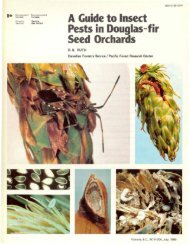decay of aspen and balsam poplar in alberta - Canadian Forest ...
decay of aspen and balsam poplar in alberta - Canadian Forest ...
decay of aspen and balsam poplar in alberta - Canadian Forest ...
Create successful ePaper yourself
Turn your PDF publications into a flip-book with our unique Google optimized e-Paper software.
10<br />
Table 2. Age.<strong>decay</strong> relationships <strong>in</strong> <strong>aspen</strong> st<strong>and</strong>s <strong>in</strong> Canada <strong>and</strong> the United States<br />
Age class Manitoba-<br />
(years) M<strong>in</strong>nesota a<br />
E. S",k b<br />
31-40 1.4<br />
41·50 1.8<br />
51·60 4.7 3.2<br />
61·70 5.9 7.1<br />
71·80 5.6 14.4<br />
81·90 3.0 21.3<br />
91·100 11.5 25.2<br />
101·110 18.1 31.1<br />
111·120 26.5 36.9<br />
121·130 41.5 41.9<br />
131·140 10.3<br />
141·150 22.5<br />
151·160<br />
161·170<br />
171·180<br />
a Me<strong>in</strong>ecke (1929).<br />
b Black <strong>and</strong> Kristapovich (1954).<br />
c<br />
Riley (1952).<br />
d<br />
Basham (1958).<br />
e<br />
Paul <strong>and</strong> Etheridge (1958).<br />
f Bailey <strong>and</strong> Dobie (1977).<br />
g H<strong>in</strong>ds <strong>and</strong> Wengert (1977).<br />
h Pedology Consultants (1982).<br />
Petawawa, Upper Pic.<br />
OntarioC Ontario d<br />
2.9<br />
4.4<br />
5.9 1.0<br />
7.4<br />
8.9 3.0<br />
Better correlations between site <strong>and</strong> <strong>decay</strong> were<br />
obta<strong>in</strong>ed when the factors <strong>of</strong> site quality <strong>and</strong> competition<br />
were considered. Paul <strong>and</strong> Etheridge (1958) divided the<br />
sample trees <strong>in</strong>to fast- <strong>and</strong> slow-grow<strong>in</strong>g classes. Slow<br />
grow<strong>in</strong>g <strong>aspen</strong> <strong>and</strong> <strong>poplar</strong> occur as a rule on the poor<br />
sites <strong>and</strong> very rarely make up the understory trees on the<br />
better sites. The fast-grow<strong>in</strong>g trees usually occur on good<br />
sites but may occasionally <strong>in</strong>clude some dom<strong>in</strong>ants from<br />
In -<strong>aspen</strong>, highly significant differences have been<br />
found between clones <strong>in</strong> percentage <strong>decay</strong>, volume <strong>of</strong><br />
<strong>decay</strong>, gross volume, <strong>and</strong> net volume (Kemperman et al.<br />
1978; Wall 1969, 1971). Wall (1971) reported that<br />
5.0<br />
8.0<br />
8.0<br />
15.0<br />
17.0<br />
Percentage <strong>decay</strong><br />
Lesser Slave Lesser Slave Rocky-Clear-<br />
Lake, Alta. e<br />
Lake, Alta. i<br />
Colorado g<br />
water, Alta. h<br />
12.0<br />
14.0<br />
30.0 6.2 6.5<br />
40.0<br />
42.0 8.4 14.5 8.7<br />
40.0<br />
36.0 12.2 23.0<br />
33.0<br />
30.0 31.0<br />
45.0<br />
48.5<br />
the poorer sites. The diameter classes y'ield<strong>in</strong>g the<br />
maximum net <strong>in</strong>crements <strong>in</strong> fast- <strong>and</strong> slow-grow<strong>in</strong>g<br />
<strong>aspen</strong> were 35 em <strong>and</strong> 30 em, respectively. In fast- <strong>and</strong><br />
slow·grow<strong>in</strong>g <strong>balsam</strong> <strong>poplar</strong>, the diameter classes<br />
yield<strong>in</strong>g the maximum net <strong>in</strong>crement were 58 em <strong>and</strong><br />
56 em, respectively. It appears, however, that genetic<br />
factors significantly affect site-<strong>decay</strong> relationships <strong>in</strong><br />
<strong>aspen</strong>.<br />
CLONE·DECA Y RELATIONSHIPS<br />
each clone had a unique pattern with respect to position<br />
<strong>of</strong> rot columns with<strong>in</strong> the stem (Fig. 16) <strong>and</strong> the major<br />
types <strong>of</strong> rot present. Adjacent or <strong>in</strong>term<strong>in</strong>gled clones<br />
apparently on the same site differed significantly


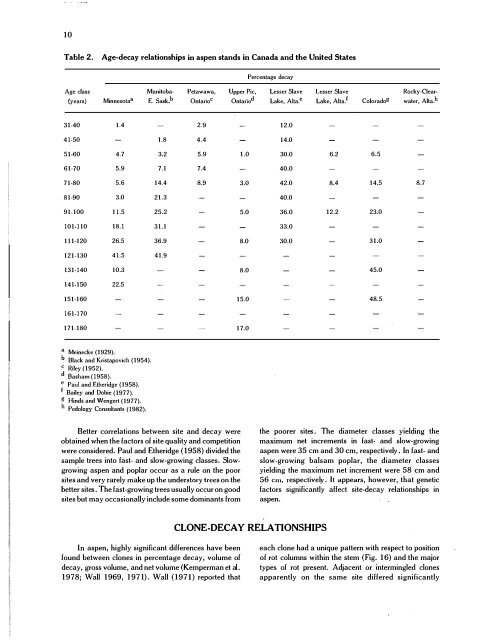
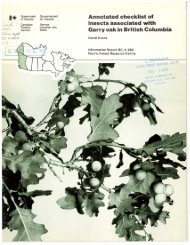
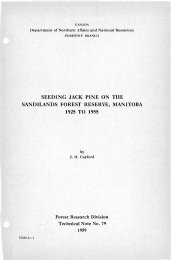
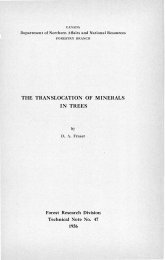
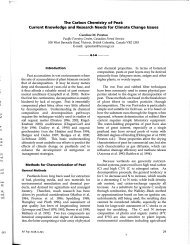


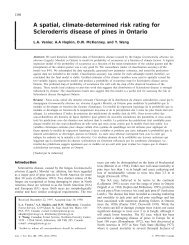

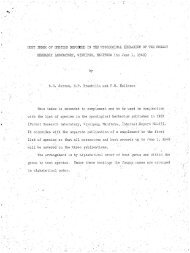

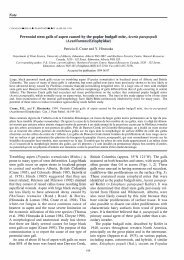
![Po],rell](https://img.yumpu.com/11946277/1/190x231/porell.jpg?quality=85)
